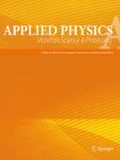Abstract
Equal-Channel Angular Pressing (ECAP) was carried out on 7075 aluminum alloy with a process route of Bc mode, thus, achieving the aims of refining crystal grains and improving alloy plasticity. To save cost and optimize the ECAP process, DEFORM finite element simulation of the ECAP extrusion process was conducted to determine the ratio of die shear Angle to extrusion. The results show that the mold optimum process parameters are 135° for the shear angle (Φ) and λ = 2 the extrusion ratio. The deformation and processing stability of the alloy at the same time met the requirements. From the simulation and experimental results of the ECAP sample, the grain size of 7075 aluminum alloy after Bc-ECAP was obviously refined from 17.311 to 9.310 μm, and the grain shape more round. The equiaxed property of the grain was also improved, and the tissue distribution more uniform. Even though the strength of 7075 aluminum alloy slightly decreased, its plasticity increased significantly from 9.9 to 18.6%.















Similar content being viewed by others
References
K. Senthil, M.A. Iqbal, P.S. Chandel et al., Study of the constitutive behavior of 7075-T651 aluminum alloy. Int. J. Impact Eng 108, 171–190 (2017). https://doi.org/10.1016/j.ijimpeng.2017.05.002
J.J. Bhattacharyya, S.R. Agnew, M.M. Lee et al., Measuring and modeling the anisotropic, high strain rate deformation of Al alloy, 7085, plate in T711 temper. Int. J. Plast. (2017). https://doi.org/10.1016/j.ijplas.2017.03.001
P. Zhang, Y. Wang, Effects of heat treatment on the nanoscale precipitation behavior of 7055 aluminum alloy under dynamic shock. Vacuum 152, 150–155 (2018). https://doi.org/10.1016/j.vacuum.2018.03.016
L. Shuai, H. Dong, S. Lei et al., Corrosion behavior and mechanical properties of Al–Zn–Mg aluminum alloy weld. Corros. Sci. (2017). https://doi.org/10.1016/j.corsci.2017.05.007
F. Khodabakhshi, A.P. Gerlich, Accumulative fold-forging (AFF) as a novel severe plastic deformation process to fabricate a high strength ultra-fine grained layered aluminum alloy structure. Mater. Charact. 136, 229–239 (2018). https://doi.org/10.1016/j.matchar.2017.12.023
K. Kyzioł, S. Kluska, M. Januś et al., Chemical composition and selected mechanical properties of Al–Zn alloy modified in plasma conditions by RF CVD. Appl. Surf. Sci. 311, 33–39 (2014). https://doi.org/10.1016/j.apsusc.2014.04.193
K. Kyzioł, K. Koper et al., Plasmochemical modification of aluminum–zinc alloys using NH3-Ar atmosphere with anti-wear coatings deposition. Mater. Chem. Phys. (2017). https://doi.org/10.1016/j.matchemphys.2016.12.046
H. Alihosseini, M.A. Zaeem, K. Dehghani et al., Producing high strength aluminum alloy by combination of equal channel angular pressing and bake hardening. Mater. Lett. 140, 196–199 (2015). https://doi.org/10.1016/j.matlet.2014.10.163
S. Sabbaghianrad, T.G. Langdon, An evaluation of the saturation hardness in an ultrafine-grained aluminum 7075 alloy processed using different techniques. J. Mater. Sci. 50(12), 4357–4365 (2015). https://doi.org/10.1007/s10853-015-8989-x
L. Tang, G. Xu, Y. Deng et al., Mechanical properties and microstructure of an Al–Zn–Mg–Sc–Zr alloy processed by warm equal channel angular pressing and subsequent aging. JOM (2017). https://doi.org/10.1007/s11837-017-2616-z
M. Chegini, M.H. Shaeri, Effect of equal channel angular pressing on the mechanical and tribological behavior of Al–Zn–Mg–Cu alloy. Mater. Charact. 140, 147–161 (2018). https://doi.org/10.1016/j.matchar.2018.03.045
M. Shaban Ghazani, M.R. Akbarpour, Plastic deformation characteristics of the rotary ECAP with two different routes. Trans. Indian Inst. Met. (2017). https://doi.org/10.1007/s12666-017-1132-8
M. Torabi, A.R. Eivani, H. Jafarian et al., Die design modification to improve workability during equal channel angular pressing: die design modification to improve workability…. Adv. Eng. Mater. 18(8), 1469–1477 (2016). https://doi.org/10.1002/adem.201600110
X.X. Wang, H.E. Min, Z. Zhu et al., Influence of twist extrusion process on consolidation of pure aluminum powder in tubes by equal channel angular pressing and torsion. Trans. Nonferrous Met. Soc. China 25(7), 2122–2129 (2015). https://doi.org/10.1016/S1003-6326(15)63823-7
G. Deng, C. Lu, L. Su et al., Influence of outer corner angle (OCA) on the plastic deformation and texture evolution in equal channel angular pressing. Comput. Mater. Sci. 81, 79–88 (2014). https://doi.org/10.1016/j.commatsci.2013.07.006
S.G. Mehdi, F.I. Ali, B. Behzad, Analysis of the plastic strain distribution and damage accumulation during T-shaped equal channel angular pressing. Trans. Indian Inst. Met. (2018). https://doi.org/10.1007/s12666-018-1387-8
C. Yu, Study on ECAP Process and Numerical Simulation of 7075 Aluminum Alloy (Nanchang Aeronautical University, Nanchang, 2014)
Author information
Authors and Affiliations
Corresponding author
Additional information
Publisher's Note
Springer Nature remains neutral with regard to jurisdictional claims in published maps and institutional affiliations.
Rights and permissions
About this article
Cite this article
Xu, X., Chen, H., Jiang, Z. et al. Parameter optimization of extrusion-Bc ECA technology and its effect on microstructure and properties of 7075 aluminum alloy. Appl. Phys. A 126, 298 (2020). https://doi.org/10.1007/s00339-020-03482-w
Received:
Accepted:
Published:
DOI: https://doi.org/10.1007/s00339-020-03482-w




